Characteristics Analysis of Doubly Fed Magnetic Geared Motor Considering Winding Frequency Conditions
Abstract
:1. Introduction
2. Operating Strategy of DFMGM
3. Basic Characteristics of DFMGM
3.1. Space Harmonics of the Modulated Flux Density
3.2. Torque Performances of DFMGM
3.3. No-load Back-EMF of DFMGM
4. Characteristics of the No-load Back-EMF According to Frequency Condition
5. Characteristics of the Operating Torque According to Frequency Condition
6. Characteristics of the Cogging Torque According to Frequency Condition
7. Conclusions
Author Contributions
Funding
Conflicts of Interest
References
- Rong, F.; Manfeng, D. Optimization design and analysis of a 30kW interior permanent magnet synchronous motor used in electric vehicles. In Proceedings of the 2012 15th International Conference on Electrical Machines and Systems (ICEMS), Sapporo, Japan, 21–24 October 2012. [Google Scholar]
- Jurkovic, S.; Rahman, K.M.; Savagian, P.J. Design, optimization and development of electric machine for traction application in GM battery electric vehicle. In Proceedings of the 2015 IEEE International Electric Machines & Drives Conference (IEMDC), Coeur d’Alene, ID, USA, 10–13 May 2015. [Google Scholar]
- Raminosoa, T.; Torrey, D.A.; El-Refaie, A.; Pan, D.; Grubic, S.; Grace, K. Robust Non-Permanent Magnet Motors for Vehicle Propulsion. In Proceedings of the 2015 IEEE International Electric Machines & Drives Conference (IEMDC), Coeur d’Alene, ID, USA, 10–13 May 2015. [Google Scholar]
- Raminosoa, T.; Torrey, D.; El-Refaie, A.; Grace, K.; Pan, D.; Grubic, S.; Bodla, K.; Huh, K.K. Sinusoidal reluctance machine with DC winding: an attractive non-permanent magnet option. IEEE Trans. Ind. Appl. 2016, 52, 2129–2137. [Google Scholar] [CrossRef]
- Wang, L.L.; Shen, J.X.; Luk, P.C.K.; Fei, W.Z.; Wang, C.F.; Hao, H. Development of a magnetic-geared permanent-magnet brushless motor. IEEE Trans. Magn. 2009, 45, 4578–4581. [Google Scholar] [CrossRef] [Green Version]
- Jian, L.; Gong, W.; Xu, G.; Liang, J.; Zhao, W. Integrated magnetic-geared machine with sandwiched armature stator for low-speed large-torque applications. IEEE Trans. Magn. 2012, 48, 4184–4187. [Google Scholar] [CrossRef]
- Zhang, X.; Liu, X.; Chen, Z. A novel coaxial magnetic gear its integration with permanent-magnet brushless motor. IEEE Trans. Magn. 2016, 52. [Google Scholar] [CrossRef]
- Guo, X.; Wu, S.; Fu, W.; Liu, Y.; Wang, Y.; Zeng, P. Control of a dual-stator flux-modulated motor for electric vehicles. Energies 2016, 9, 517. [Google Scholar] [CrossRef]
- Chen, Y.; Fu, W.; Weng, X. A concept of general flux-modulated electric machines based on a unified theory and its application to developing a novel doubly-fed dual-stator motor. IEEE Trans. Ind. Electron. 2017, 64, 9914–9923. [Google Scholar] [CrossRef]
- Wang, Y.; Ho, S.L.; Fu, W.N.; Shen, J.X. A novel brushless doubly fed generator for wind power generation. IEEE Trans. Magn. 2012, 48, 4172–4175. [Google Scholar] [CrossRef]
- Padmanathan, P.; Bird, J.Z. A continuously variable magnetic gear. In Proceedings of the 2013 International Electric Machines & Drives Conference, Chicago, IL, USA, 12–15 May 2013. [Google Scholar]
- Zheng, P.; Bai, J.; Tong, C.; Sui, Y.; Song, Z.; Zhao, Q. Investigation of a novel radial magnetic-field-modulated brushless double-rotor machine used for HEVs. IEEE Trans. Magn. 2013, 49, 1231–1241. [Google Scholar] [CrossRef]
- Bai, J.; Zheng, P.; Tong, C.; Song, Z.; Zhao, Q. Characteristics analysis and verification of the magnetic-field-modulated brushless double-rotor machine. IEEE Trans. Ind. Electron. 2015, 62, 4023–4033. [Google Scholar] [CrossRef]
- Sun, L.; Cheng, M.; Jia, H. Analysis of a novel magnetic-geared dual-rotor motor with complementary structure. IEEE Trans. Ind. Electron. 2015, 62, 6737–6747. [Google Scholar] [CrossRef]
- Bai, J.; Zheng, P.; Cheng, L.; Zhang, S.; Liu, J.; Liu, Z. A new magnetic-field-modulated brushless double-rotor machine. IEEE Trans. Magn. 2015, 51. [Google Scholar] [CrossRef]
- Liu, Y.; Ho, S.L.; Fu, W.N.; Zhang, X. Design optimization of a novel doubly fed dual-rotor flux-modulated machine for hybrid electric vehicles. IEEE Trans. Magn. 2015, 51. [Google Scholar] [CrossRef]
- Atallah, K.; Calverley, S.D.; Howe, D. Design, analysis and realization of a high-performance magnetic gear. IEE Proc-Electr. Power Appl. 2004, 151, 135–143. [Google Scholar] [CrossRef]
- Spargo, C.M.; Mecrow, B.C.; Widmer, J.D. A seminumerical finite-element postprocessing torque ripple analysis technique for synchronous electric machines utilizing the air-gap maxwell stress tensor. IEEE Trans. Magn. 2014, 50. [Google Scholar] [CrossRef]


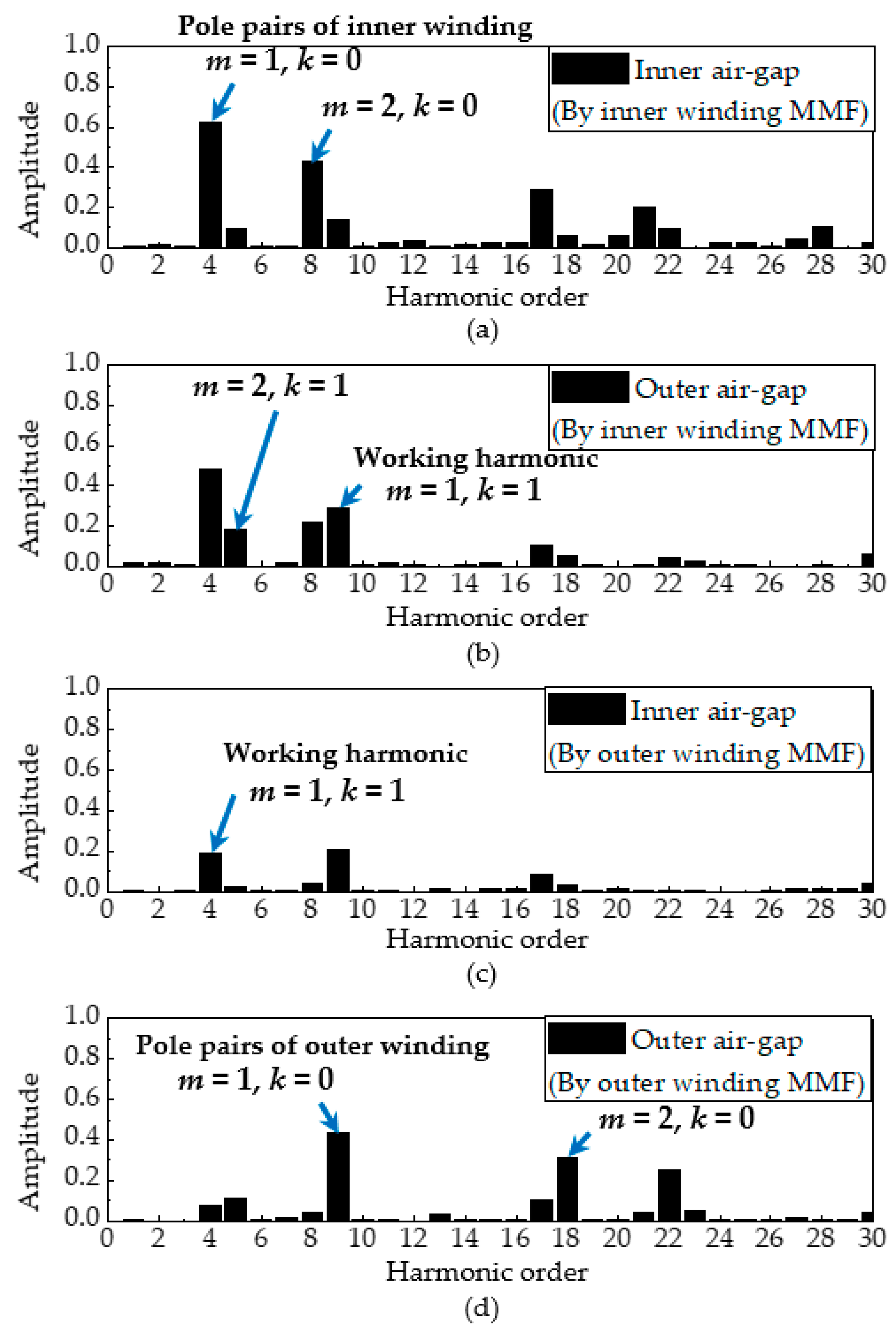
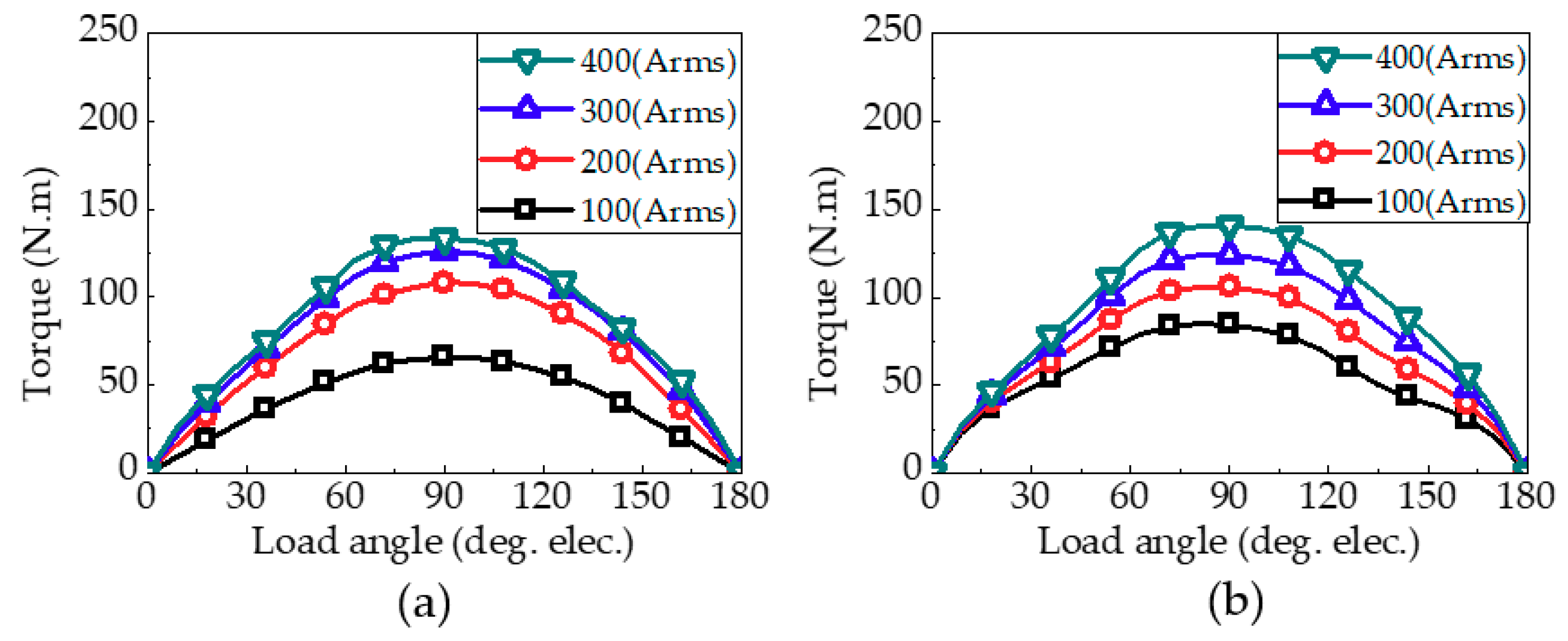
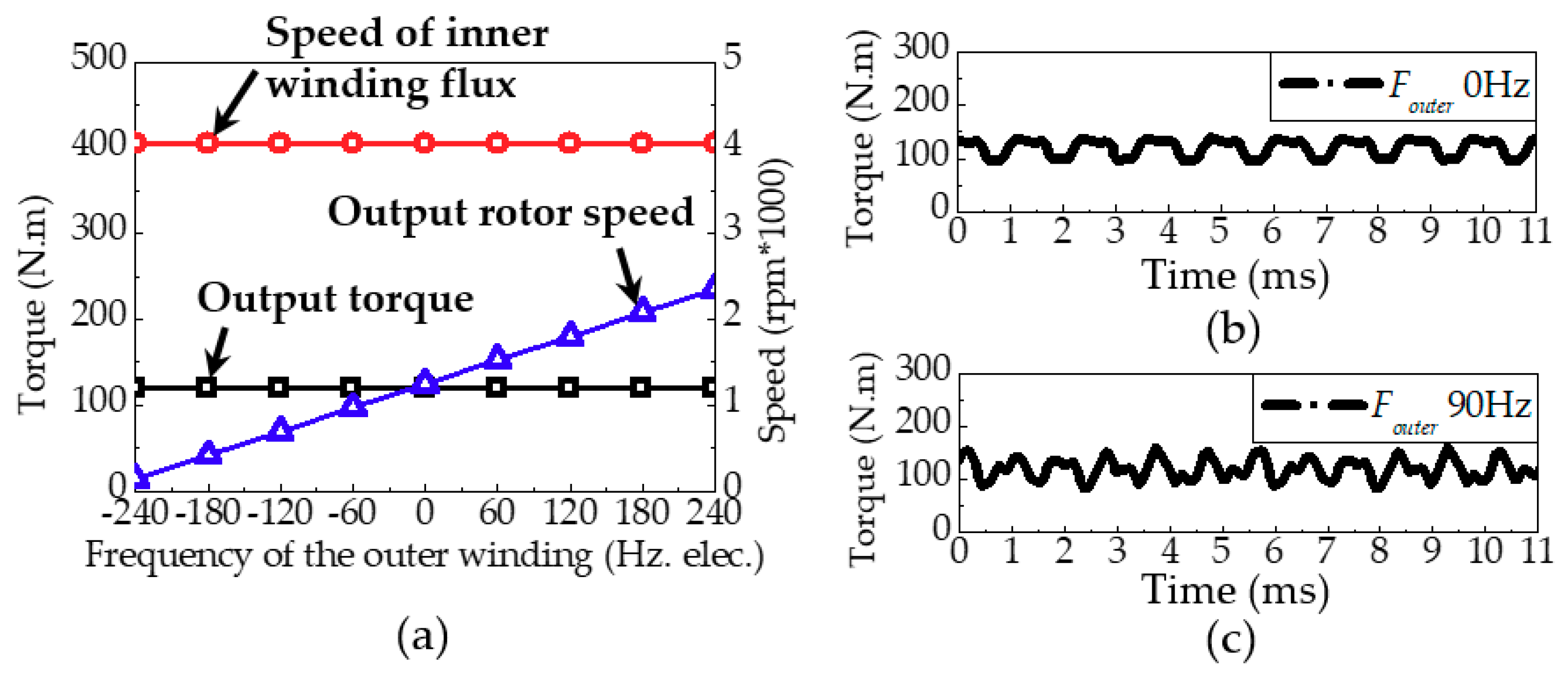
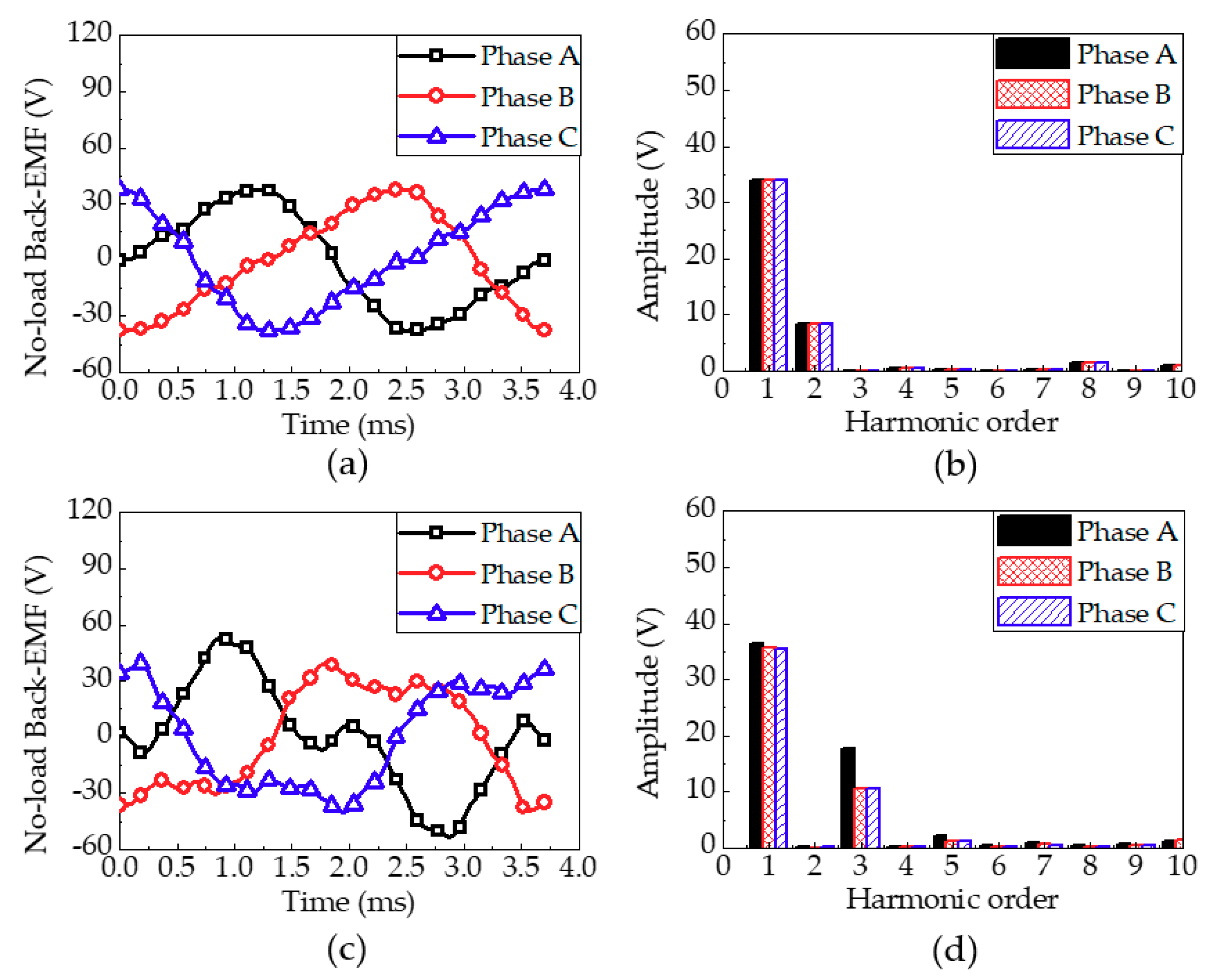

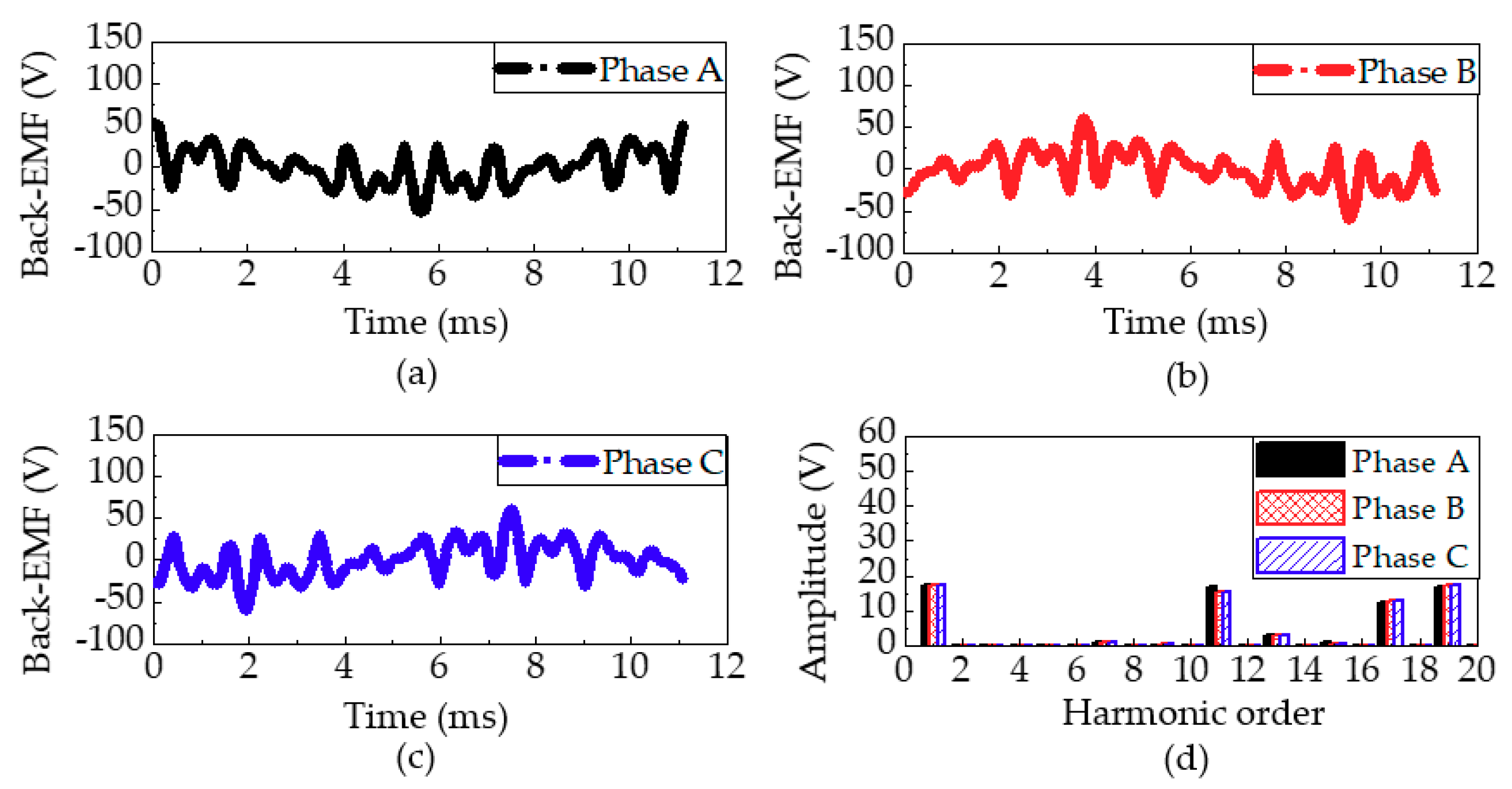
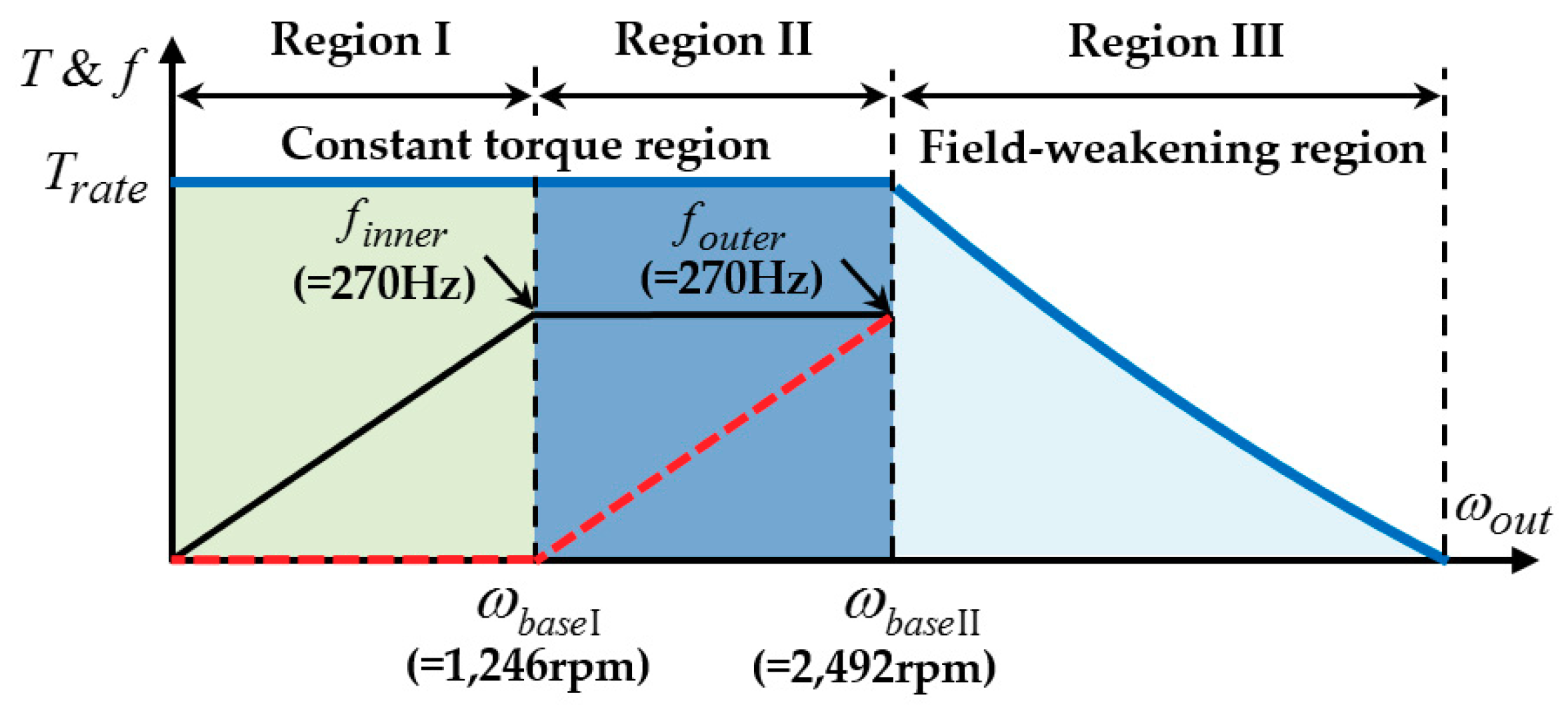
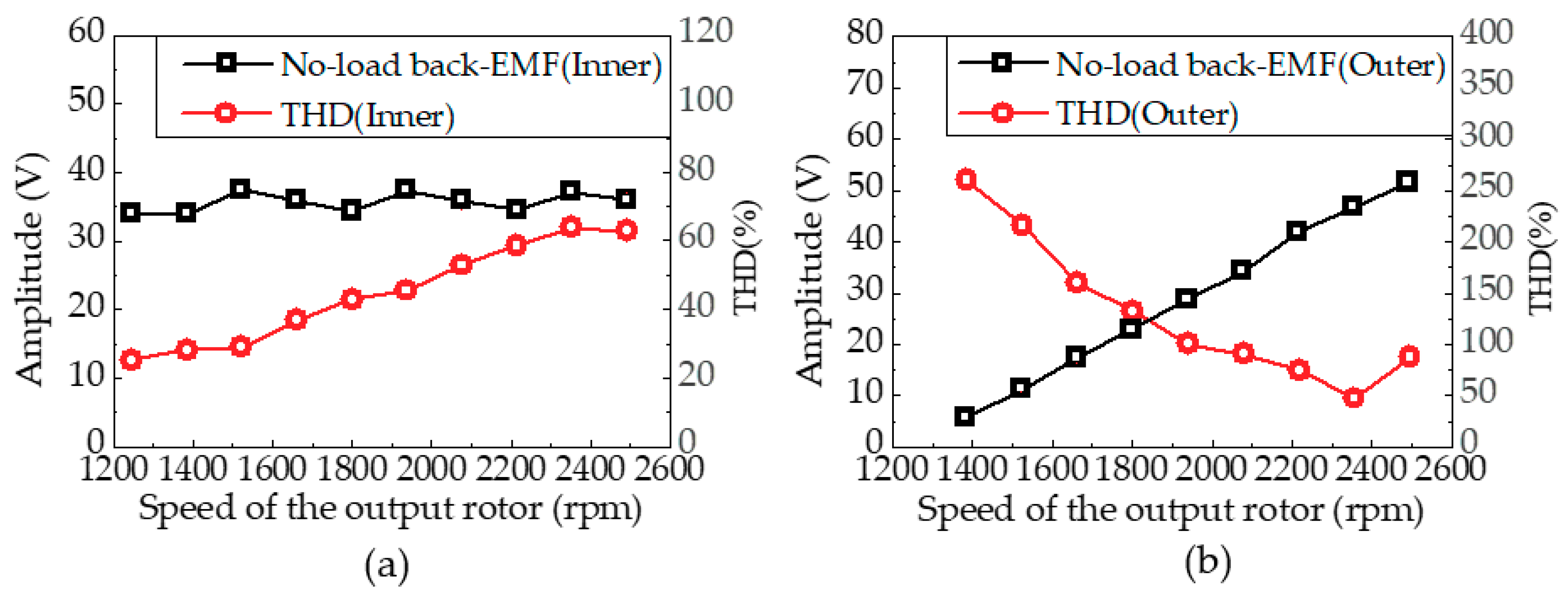
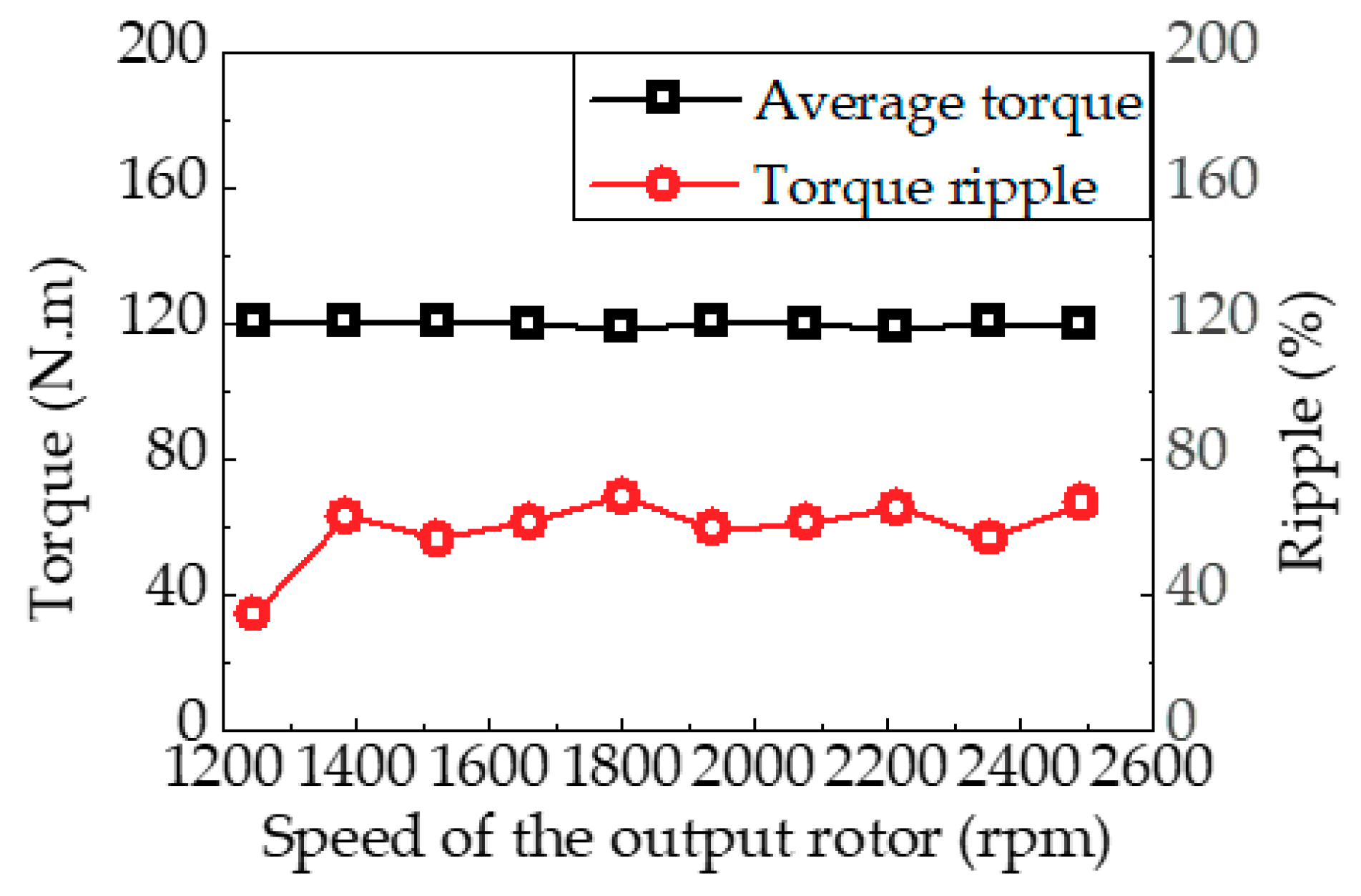
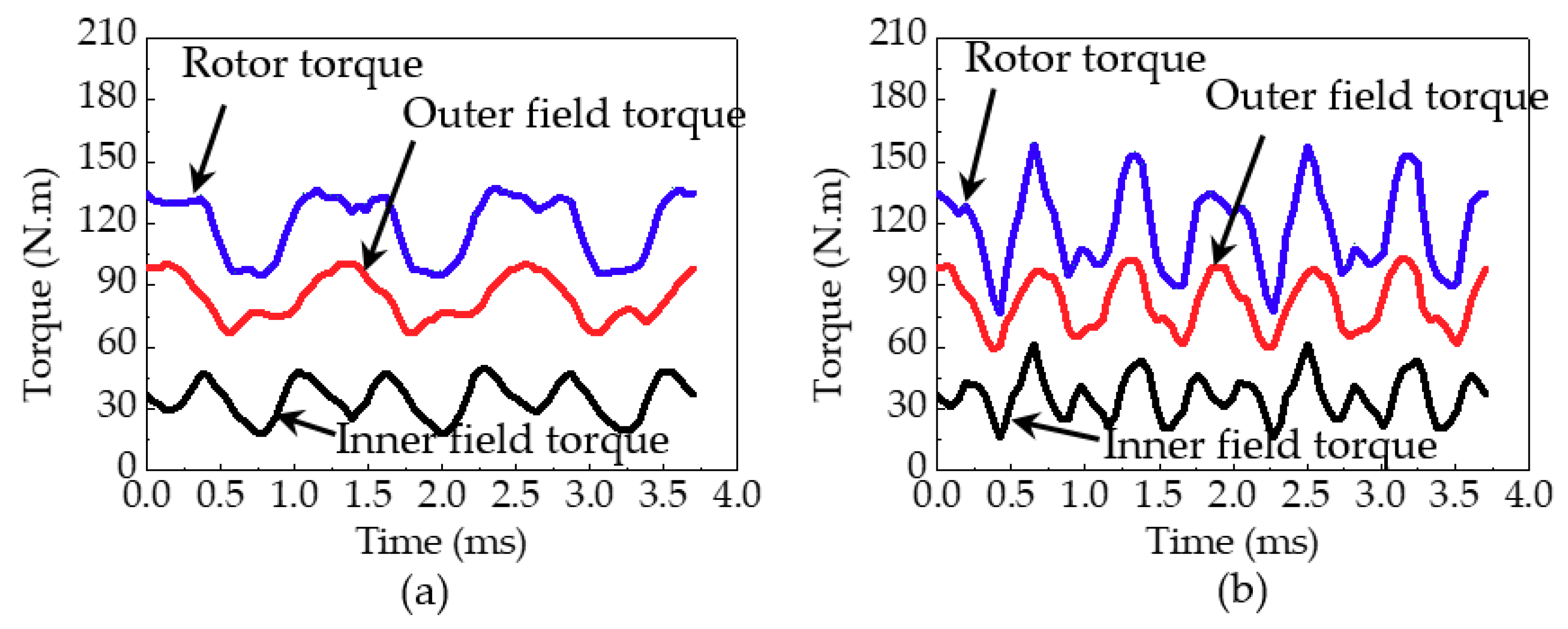
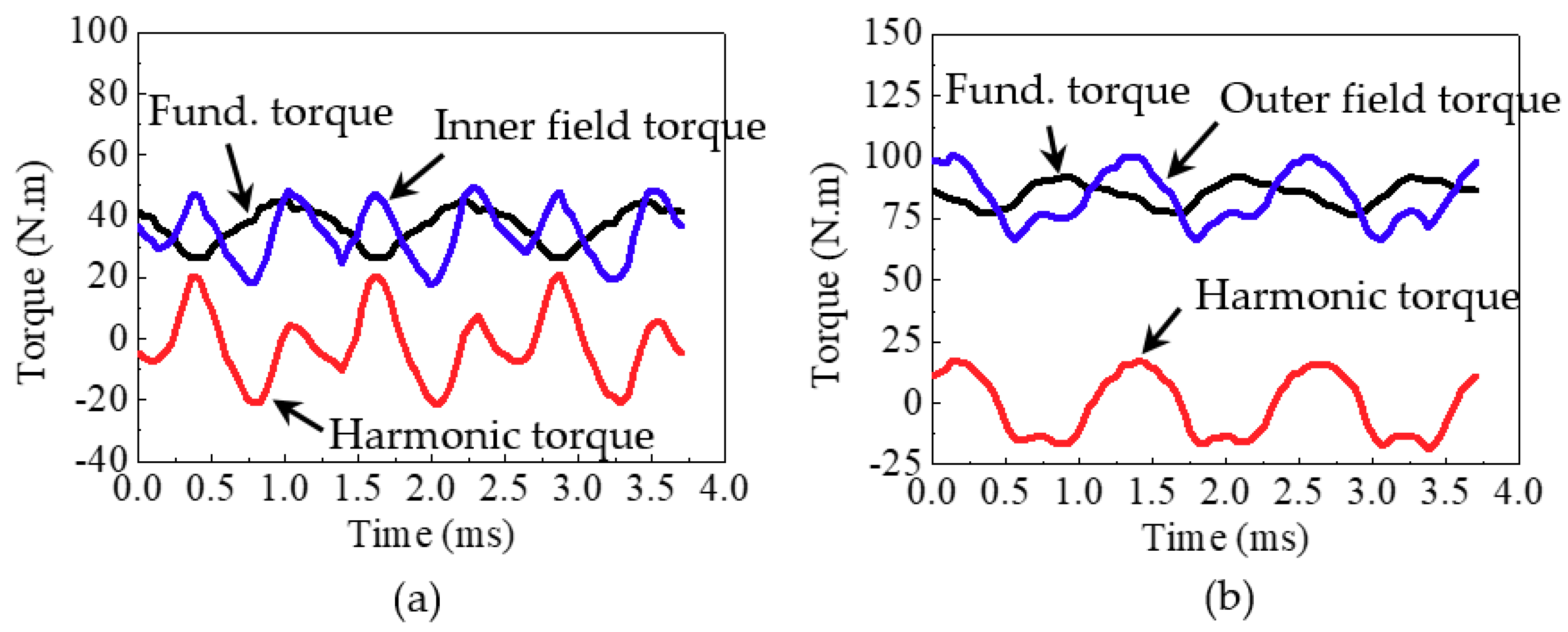

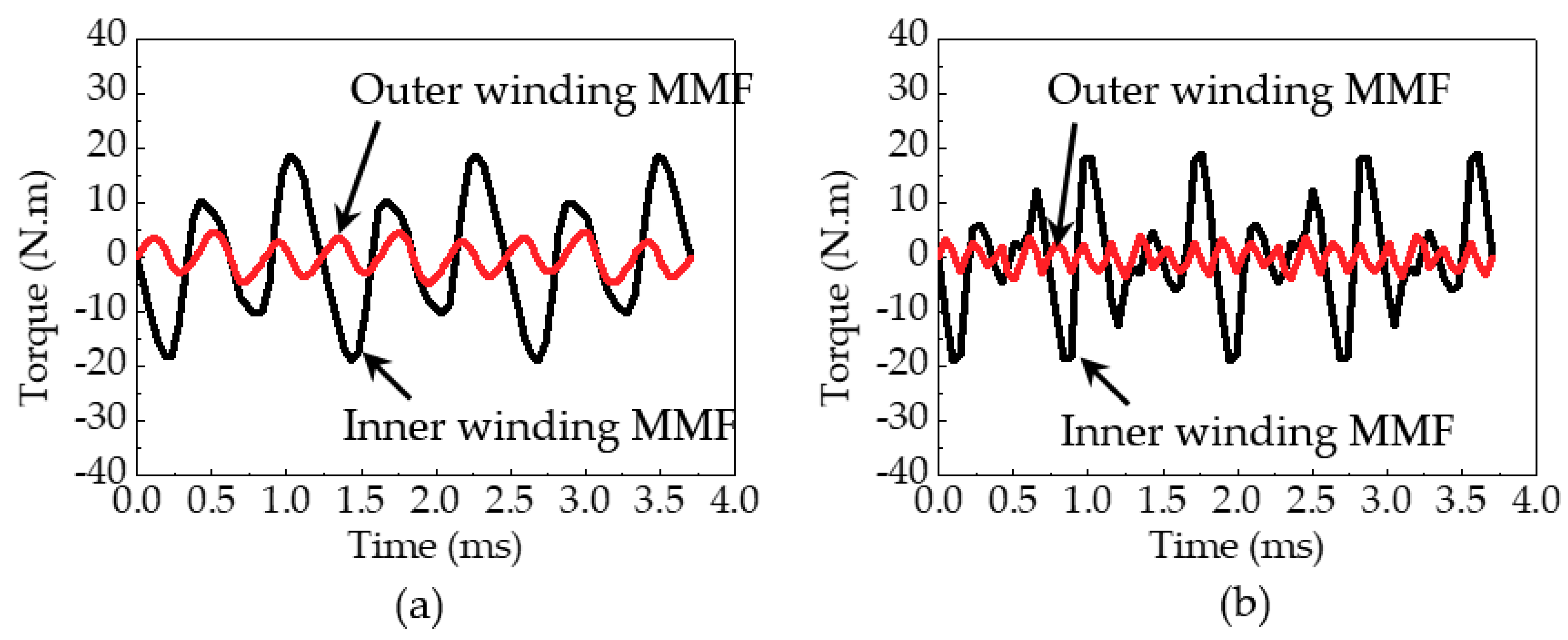
| Contents | Value |
|---|---|
| Diameter (mm) | 269 |
| Stack length (mm) | 156 |
| Number of pole pair of inner winding | 4 |
| Number of pole pair of outer winding | 9 |
| Number of modulating pieces | 13 |
| Base speed (rpm) | 2492 |
| Current density of wire (Arms/mm2) | 10 |
| Fill factor | 0.55 |
| Phase Current (inner/outer), (Arms) | 424/168 |
| Number of turns per phase (inner/outer) | 16/36 |
| Contents | Inner Winding | Outer Winding |
|---|---|---|
| Type | Concentrated | |
| Layer | Double | |
| Number of slots | 12 | 27 |
| Number of slots per phase per pole, Spp | 1/2 | 1/2 |
| Number of coils | 4 | 9 |
| Number of turns per coil | 4 | 4 |
| Number of turns per phase | 16 | 36 |
| Wire | AWG1 | AWG5 |
© 2018 by the authors. Licensee MDPI, Basel, Switzerland. This article is an open access article distributed under the terms and conditions of the Creative Commons Attribution (CC BY) license (http://creativecommons.org/licenses/by/4.0/).
Share and Cite
Shin, H.; Chang, J. Characteristics Analysis of Doubly Fed Magnetic Geared Motor Considering Winding Frequency Conditions. Energies 2018, 11, 2564. https://doi.org/10.3390/en11102564
Shin H, Chang J. Characteristics Analysis of Doubly Fed Magnetic Geared Motor Considering Winding Frequency Conditions. Energies. 2018; 11(10):2564. https://doi.org/10.3390/en11102564
Chicago/Turabian StyleShin, Homin, and Junghwan Chang. 2018. "Characteristics Analysis of Doubly Fed Magnetic Geared Motor Considering Winding Frequency Conditions" Energies 11, no. 10: 2564. https://doi.org/10.3390/en11102564






